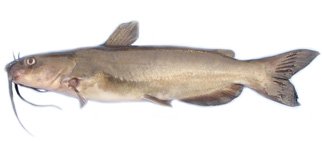Channel catfish Nutrition facts
Channel catfish is a long, slender fish living in temperate freshwater environments. It is a member of the family Ictaluridae in the order Siluriformes. Blue catfish is a closely related member.
Scientific Name: Ictalurus punctatus. Genus: Ictalurus.
Some of the common names are channel cat, Azul, bagre de canal, pyatnistyi (Russian), prickig dvärgma (Sweden), lake catfish, northern catfish, spotted catfish, barbue de rivière (France), and Gatfish (Canada).
 |
| Channel catfish (Ictalurus punctatus). |
Description
The adult channel catfish has a long, scale-free, cylindrical, and slime body with a broad flattened head and large terminal mouth. The upper jaw is extending or protruding beyond the lower jaw. It has four pairs of long whiskers (barbels) around its mouth.
The upper part of its body in channel catfish is grey, blue, olive, or black with dark spots along the flank. Its belly surface is gray-white. Dark spots appear only in young channels; however, they tend to disappear in adults. A small fleshy (adipose) fin is present posterior to the dorsal fin. Its tail is deeply forked, with the top of the fin being larger than the rounded bottom portion.
A typical channel catfish catch generally measures 12 to 20 inches and weighs about 5-8 pounds.
Habitat
Channel cat is a freshwater fish that prefers to inhabit close to soft mud bottoms where vegetation is found. Adult carp often undertake long-distance migrations during spawning in search of suitable backwaters.
They feed on aquatic plants, zooplankton, worms, insect larvae, crustaceans, and mollusks.
Biology
Channel cats are fast-growing fish that typically reach 25 to 30 cm at two to five years of age when they are sexually mature. Adults first spawn at two or three years of age.
Spawning occurs in late spring and early summer in warm waters.
Channel catfish generally live 6 to 10 years.
Aquaculture
Farm-raised catfish is the largest aquaculture industry in the United States. Mississippi is the world's leading producer of pond-raised catfish
Channel catfish are introduced species in many European and Asian countries and successfully farmed freshwater fish in mainland China. They are reared alone or with Carp fish species that can be produced in large ponds, natural lakes, and reservoirs.
Health benefits of Channel catfish
On average, channel cat holds about 95 calories per 100 grams. American Heart Association (AHA) recommends the consumption of one to two meals of non-fried fish to fulfill requirements of essential fatty acids, protein, minerals, and fat-soluble vitamins.
Channel catfish is a non-oily, freshwater, white fish. It is one of the finest sources of omega fatty acids, protein, minerals, and fat-soluble vitamins like vitamins A, E, and D.
Channel catfish is moderately good source of protein (17.8 g/100 g -32% of RDI). Its white, flaky meat is firm and composes all the essential amino acids in good proportions.
It's lean meat is a good source of polyunsaturated fatty acids (PUFA). Studies suggest a diet rich in fish that are high in omega-3 fatty acids can curb or prevent cognitive decline, dementia, depression, neuropsychiatric disorders, asthma, and inflammatory disorders.
Channel cat contains just 0.024 ppm of methyl-mercury in its flesh. US FDA categorizes channel catfish in the "best choice" section considering mercury levels in its flesh. The recommendation is the consumption of 2-3 servings (8-12 ounces) per week for channel cat.
It is a moderate source of omega-3 eicosapentaenoicacid (EPA), docosapantaenoicacid (DPA) and docosahexaenoic acid (DHA) fatty acids. Research studies suggest that these fatty acids, particularly DHA, play an important role in the development of the nervous system, especially in infants and children.
According to Cornell University and the New York Sea Grant Extension Program. 2012- The fatty acids play a crucial role in decreasing blood pressure and heart rate and help improve cardiovascular function. For example, research has shown that omega-3 fatty acids decrease the risk of arrhythmias (abnormal heartbeats) that can lead to sudden death.
100 g of channel catfish holds 500 IU of vitamin D; about 83% of daily recommended intake. Vitamin D plays an important role in the calcium metabolism and offers protection from cancers.
It composes small amounts of vitamin-A (50 IU/100 g) in its flesh; Nonetheless, it composes moderate amounts of omega-3 essential fatty acids such as ALA, DHA, and DPA which help maintain healthy mucosa and skin.
Channel catfish compose several B-complex vitamins such as niacin, thiamin, and vitamin-B12 (2.23 μg-93% RDA). It is also a good source of pyridoxine (B-6), vitamin E, and riboflavin.
Furthermore, channel cats compose significant amounts of minerals including calcium, potassium, phosphorus, and magnesium. The other trace elements commonly found in this fish are selenium and iodine. Iodine is an important trace element in human nutrition and is essential for thyroid hormone production.
| Principle | Nutrient Value | Percent of RDA |
|---|---|---|
| Energy | 95 Kcal | 4.75% |
| Carbohydrates | 0 g | 0% |
| Protein | 16.4 g | 29% |
| Total Fat | 2.82 g | 14% |
| Cholesterol | 58 mg | 19% |
| Dietary Fiber | 0 g | 0% |
| Vitamins | ||
| Folate total | 10 μg | 2.5% |
| Niacin | 1.91 mg | 12% |
| Pyridoxine | 0.116 mg | 9% |
| Riboflavin | 0.072 mg | 5.5% |
| Thiamin | 0.210 mg | 17.5% |
| Vitamin-A | 50 IU | 1.66% |
| Vitamin-B12 | 2.23 μg | 93% |
| Vitamin-D | 500 IU | 83% | Electrolytes |
| Sodium | 43 mg | 3% |
| Potassium | 358 mg | 7.6% |
| Minerals | ||
| Calcium | 14 mg | 1.4% |
| Iron | 0.3 mg | 4% |
| Magnesium | 23 mg | 6% |
| Phosphorus | 209 mg | 30% |
| Selenium | 12.6 mg | 23% |
| Zinc | 0.51 mg | 4.6% | Omega-3 fats (PUFA) |
| EPA (20:5 n-3) | 0.130 g | -- |
| DPA (22:5 n-3) | 0.100 g | -- |
| DHA (22:6 n-3) | 0.234 g | -- |
Buying
Fresh channel cat seasonality is August to December. It is usually sold whole dressed (gilled, gutted, scaled), both fresh and frozen, and as steaks, skinless and boneless fillets, and fillet strips, and as whole dressed fish.
In the supermarkets, one may come across breaded fillets and nuggets, marinated fillets, and smoked (fillets and dressed fish).
Like all fish, channel cat also tends to spoil early. To store at home, wrap the fish in heavy-duty freezer bags. Store in the freezer at 0 F or lower. Thaw in the refrigerator at between 25 and 30 degrees F for 24-48 hours before cooking.
Preparation
The channel catfish will have a slimy surface that needs to be cleaned before cooking. If you buy whole, gutted fish with intact skin, gently scrub the skin with a lemon slice, and scrape with a blunt knife to remove pigment slime, and wash again in clean water.
Channel cat is a mild-sweet tasting, firm-textured, white freshwater fish that easily takes on flavors of ingredients in cooking.
It can be employed in any number of cooking methods; deep-fry, pan-fry, bake, broil, grill, smoke, sauté, and steam.
 |
| Deep-fried catfish-Classic-Southern dish. Photo credit: The Catfish Institute. |
Channel catfish is one of the most popular freshwater fish eaten in the Southern states of the US. Cornmeal-coated, deep-fried catfish is served with hushpuppies, coleslaw tarte sauce, and lemon slices.
It can be substituted for cod and hake for popular UK-style Fish-and-chips.
It is also prepared delicious soups, chowder, stews, and curries.
Popular value-added catfish products include fish cakes, pies, nuggets, fish balls, and patties.
Safety profile
The mean methyl-mercury concentration in channel catfish is 0.024 ppm. Accordingly, the U.S. FDA's final guidelines on how much fish expectant as well as breastfeeding mothers can eat, along with lists of specific options that are safe or should be avoided, place it in "the best choice" category. By this yardstick, they can consume 2-3 servings (8-12 ounces) of this fish per week.
Some processing units have been known to soak catfish fillets in sodium tripolyphosphate solution to add moisture and weight, resulting in an inferior product. Buyers should avoid fillets that are brown or gray in color. (Medical disclaimer).
Also read ≻≻-
≺≺- Mercury in Fish: Health Benefits, Risks, and Safe Choices
≻≻- Atlantic cod nutrition facts and health benefits.
≻≻- Trout fish nutrition facts and health benefits.
≻≻- Halibut nutrition facts and health benefits.
≻≻- Back to Seafood from Channel catfish nutrition facts and health benefits.
Further reading (Links opens in new window):
CABI -Invasive Species Compendium-Ictalurus punctatus.
Omega-3 Fatty Acids: An Essential Contribution.
Department of Energy and Environmental Protection-Connecticut.
New AHA guidelines recommend eating fish twice a week to improve heart health.